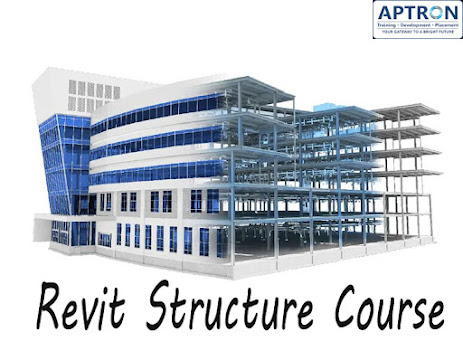Revit Structure Course in Noida
Revit Structure Course in Noida - APTRON Solutions
Are you looking to master the art of structural design and analysis using Autodesk Revit in Noida? Look no further! APTRON Solutions offers a comprehensive Revit Structure course that will equip you with the skills and knowledge needed to excel in the world of structural engineering and architecture.
Why Choose APTRON Solutions for Revit Structure Training in Noida?
Expert Trainers: At APTRON Solutions, we pride ourselves on having a team of experienced and certified trainers who are well-versed in Revit Structure. They will guide you through every aspect of the software, ensuring you have a strong foundation and hands-on experience.
Comprehensive Curriculum: Our Revit Structure course covers everything from the basics to advanced topics, including creating 3D models, analyzing structures, and generating detailed documentation. You will learn how to optimize your workflow and design efficient, cost-effective structures.
Hands-On Practice: We believe in learning by doing. Our course includes practical exercises and projects that allow you to apply what you've learned in real-world scenarios. You'll gain confidence in your abilities and be ready to tackle complex projects.
Industry-Relevant Projects: APTRON Solutions collaborates with industry experts and professionals to create projects that mimic real-world challenges. This practical experience will give you a competitive edge in the job market.
Flexible Learning Options: We understand that everyone's schedule is different. APTRON Solutions offers flexible learning options, including weekday and weekend classes, so you can choose a schedule that suits you.
State-of-the-Art Facilities: Our training center in Noida is equipped with the latest technology and resources to facilitate an excellent learning experience.
Career Support: We not only provide training but also assist you in building a career in structural engineering. We offer job placement assistance, interview preparation, and resume-building workshops.
Certification: Upon successful completion of the Revit Structure course, you'll receive a certification from APTRON Solutions, recognized in the industry.
Who Can Benefit from this Course?
- Civil Engineers and Architects looking to enhance their structural design skills.
- Students and Fresh Graduates aspiring to enter the field of structural engineering.
- Working professionals aiming to stay updated with the latest technologies in the AEC (Architecture, Engineering, and Construction) industry.
Yes, it is possible to learn Revit on your own, but it may require dedication, self-discipline, and access to learning resources. Here are steps and tips to help you learn Revit independently:
Access to Software: First, you'll need access to Autodesk Revit software. Autodesk offers a free trial version of Revit that you can use for a limited time. Alternatively, you can obtain a student or educational license if you're a student or educator. Some organizations also provide access to Revit for training purposes.
Online Tutorials and Documentation: There are numerous online tutorials, videos, and written documentation available for learning Revit. Websites like Autodesk's own website, YouTube, and various online learning platforms offer free and paid tutorials. Start with beginner-level tutorials and progressively move to more advanced content.
Books and Courses: Consider purchasing books or enrolling in online courses specifically designed to teach Revit. Books provide structured content, while online courses often include hands-on exercises and assessments. Look for courses on platforms like Coursera, Udemy, LinkedIn Learning, and more.
Practice Regularly: Learning Revit is a hands-on process. Regular practice is crucial. Create your own small projects or try to recreate existing structures to apply what you've learned. Practice helps solidify your knowledge and improve your skills.
Community Forums and Groups: Join online communities and forums related to Revit. Websites like Autodesk's community forums, Revit City, and Reddit's r/Revit are great places to ask questions, share your work, and learn from experienced users.
Stay Updated: Revit is regularly updated, and new features are added. Keep up to date with the latest changes and features by following Autodesk's announcements and reading industry-related news.
Use Templates and Families: Utilize templates and families to streamline your work. Revit includes a library of families and templates that can save you time in your projects.
Understand BIM Principles: Revit is a Building Information Modeling (BIM) software. Understand the principles of BIM and how Revit fits into the BIM workflow. This knowledge will help you use Revit more effectively.
Set Learning Goals: Define your learning goals and objectives. Break down your learning into manageable tasks and milestones. This will help you stay focused and motivated.
Seek Feedback: Share your work with experienced Revit users and ask for feedback. Constructive criticism can help you improve your skills and knowledge.
Learning Revit on your own can be challenging, but it is feasible with dedication and the right resources. However, if you find yourself facing significant challenges or wish to accelerate your learning, consider enrolling in a formal training program or taking courses offered by educational institutions or training centers. These programs often provide structured learning and hands-on guidance.
Join APTRON Solutions today and embark on your journey to becoming a proficient Revit Structure user. Master the art of structural design and open doors to a world of opportunities in Noida's booming construction and real estate sector.
Enroll now and secure your place in the Revit Structure Course in Noida at APTRON Solutions. Don't miss this chance to upgrade your skills and take your career to new heights in the vibrant city of Noida. Contact us to learn more and get started!



Comments
Post a Comment